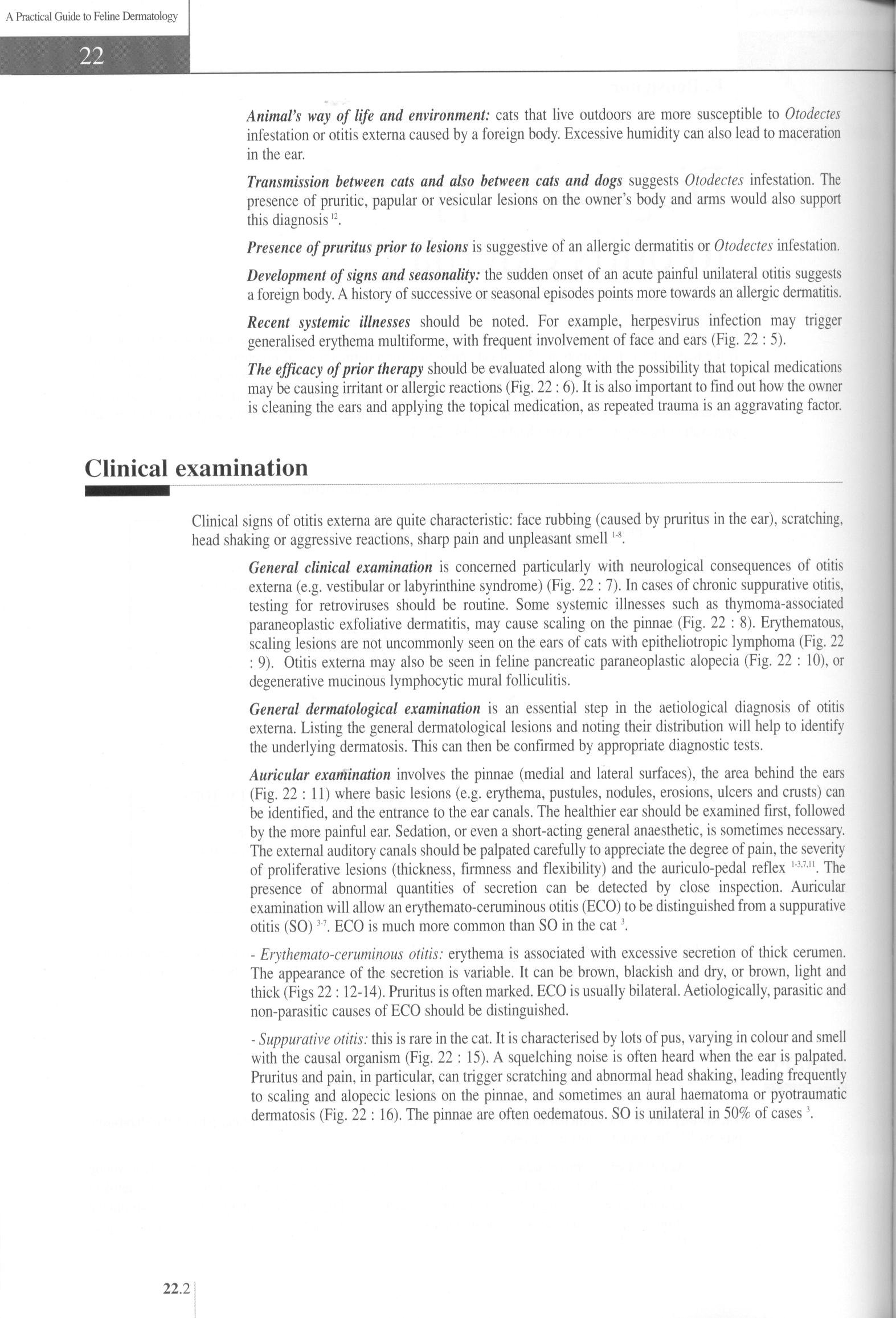222 (33)

22
A Practical Guide to Feline Dermatology
AnimaTs way of life and environment: cats that live outdoors are morę susceptible to Otodectes infestation or otitis extema caused by a foreign body. Excessive humidity can also lead to maceration in the ear.
Transmission between cats and also between cats and dogs suggests Otodectes infestation. The presence of pruritic, papular or vesicular lesions on the owner’s body and arms would also support this diagnosisl2.
Presence of pruritus prior to lesions is suggestive of an allergic dermatitis or Otodectes infestation.
Development of signs and seasonality: the sudden onset of an acute painful unilateral otitis suggests a foreign body. A history of successive or seasonal episodes points morę towards an allergic dermatitis.
Recent systemie illnesses should be noted. For example, herpesvirus infection may trigger generalised erythema multiforme, with frequent involvement of face and ears (Fig. 22 : 5).
The efficacy of prior therapy should be evaluated along with the possibility that topical medications may be causing irritant or allergic reactions (Fig. 22 : 6). It is also important to fmd out how the owner is cleaning the ears and applying the topical medication, as repeated trauma is an aggravating factor.
Clinical examination
Clinical signs of otitis extema are quite characteristic: face rubbing (caused by pruritus in the ear), scratching, head shaking or aggressive reactions, sharp pain and unpleasant smell
General clinical examination is concemed particularly with neurological consequences of otitis extema (e.g. vestibular or labyrinthine syndrome) (Fig. 22 : 7). In cases of chronic suppurative otitis, testing for retroviruses should be routine. Some systemie illnesses such as thymoma-associated paraneoplastic exfoliative dermatitis, may cause scaling on the pinnae (Fig. 22 : 8). Erythematous, scaling lesions are not uncommonly seen on the ears of cats with epitheliotropic lymphoma (Fig. 22 : 9). Otitis extema may also be seen in feline panereatie paraneoplastic alopecia (Fig. 22 : 10), or degenerative mucinous lymphocytic mural folliculitis.
General dermatological examination is an essential step in the aetiological diagnosis of otitis extema. Listing the generał dermatological lesions and noting their distribution will help to identify the underlying dermatosis. This can then be confirmed by appropriate diagnostic tests.
Auricular examination involves the pinnae (medial and lateral surfaces), the area behind the ears (Fig. 22 : 11) where basie lesions (e.g. erythema, pustules, nodules, erosions, uleers and crusts) can be identified, and the entrance to the ear canals. The healthier ear should be examined first, followed by the morę painful ear. Sedation, or even a short-acting generał anaesthetic, is sometimes necessary. The extemal auditory canals should be palpated carefully to appreciate the degree of pain, the severity of proliferative lesions (thickness, firmness and flexibility) and the auriculo-pedal reflex w,n. The presence of abnormal quantities of secretion can be detected by close inspection. Auricular examination will allow an erythemato-ceruminous otitis (ECO) to be distinguished from a suppurative otitis (SO)37. ECO is much morę common than SO in the cat \
- Erythemato-ceruminous otitis: erythema is associated with excessive secretion of thick cerumen. The appearance of the secretion is variable. It can be brown, blackish and dry, or brown, light and thick (Figs 22:12-14). Pruritus is often marked. ECO is usually bilateral. Aetiologically, parasitic and non-parasitic causes of ECO should be distinguished.
- Suppurative otitis: this is rare in the cat. It is characterised by lots of pus, varying in colour and smell with the causal organism (Fig. 22 : 15). A squelching noise is often heard when the ear is palpated. Pruritus and pain, in particular, can trigger scratching and abnormal head shaking, leading frequently to scaling and alopecic lesions on the pinnae, and sometimes an aural haematoma or pyotraumatic dermatosis (Fig. 22 : 16). The pinnae are often oedematous. SO is unilateral in 50% of cases3.
22.2
Wyszukiwarka
Podobne podstrony:
33 (337) 3 A Practical Guide to Feline DermatologyCheyletiellosisAetiopathogenesis Cheyletiellosis i
236 (22) Practical Guide to Feline Dermatology23 observed on the whole body. Nodular lesions primari
48 (209) 4 A Practical Guide to Feline Dermatology Table 4:1: Type of hair invasion, fruiting bodies
35 (267) A Practical Guide to Feline Dermatology 1 3 Table 3:1: Identification of the principal
22 (503) A Practical Guide to Feline Dermatology ■ 2 Table 2:1: Breed predispositions to common d
234 (22) 23 A Practical Guide to Feline Dermatology autumn, point towards parasitic dermatoses7 such
248 (22) 24 A Practical Guide to Feline DermatologyDiagnostic tests Given the incidence of dermatoph
58 (148) 5 A Practical Guide to Feline Dermatology severity of the illness. High titres are seen wit
65 (127) 6 A Practical Guide to Feline Dermatology Other topical antimicrobial agents, such as chlor
67 (125) 6 A Practical Guide to Feline DermatologyNocardiosisAetiopathogenesis Nocardiosis is a very
69 (119) 6 A Practical Guide to Feline DermatologyDiagnosis The diagnosis is based on lesion distrib
710 (2) 7 A Practical Guide to Feline DermatologyHerpesvirus infections Dermatological manifestation
74 (105) 7 A Practical Guide to Feline Dermatology ulcerated. Lesion distribution is multicentric bu
27 A Practical Guide to Feline Dermatology Perianal glands 1.7 Permethrin 3.12, 3.13 Persian 1.6,2.2
27 A Practical Guide to Feline Dermatology Stemphyllium spp. 5.1,7.8 Stereotypie behaviour 17.1,
272 (16) 27 A Practical Guide to Feline Dermatology Alternaria spp. 5.1,7.8 Aluminium hyroxide 15.6&
274 (18) 27 A Practical Guide to Feline Dermatology Colitis 11.2 Collagen 1.2,2.6,12.1,
278 (17) 27 A Practical Guide to Feline Dermatology I J Histoplasmosis 5.8, 7.8, 25.2 Homer’s syndro
28 (374) 2 A Practical Guide to Feline Dermatology Configuration of lesions Determining the configur
więcej podobnych podstron